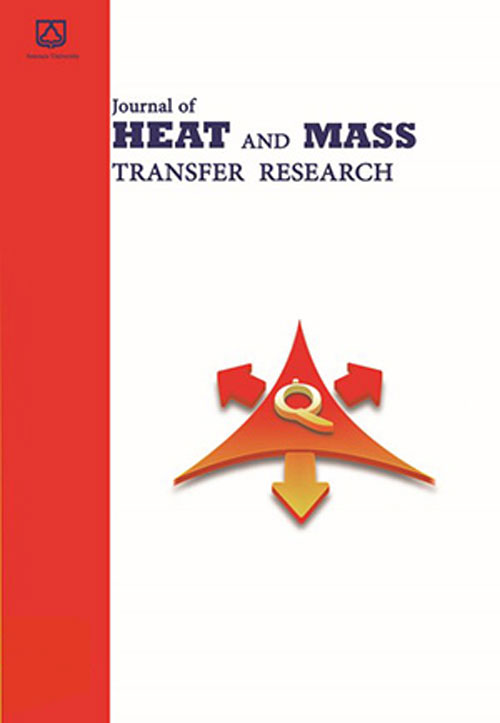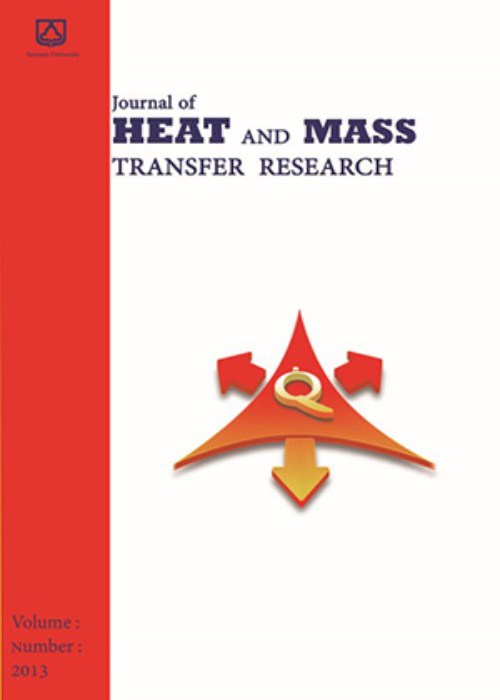فهرست مطالب

Journal of Heat and Mass Transfer Research
Volume:2 Issue: 1, Winter-Spring 2015
- تاریخ انتشار: 1395/01/20
- تعداد عناوین: 7
-
-
Page 1The permeability and tortuosity of pore-scale two and three-dimensional random porous media were calculated using the Lattice Boltzmann method (LBM). Effects of geometrical parameters of medium on permeability and tortuosity were investigated as well. Two major models of random porous media were reconstructed by computerized tomographyMethodRandomly distributed rectangular obstacles in a unit-cell as two-dimensional porous media, and random granular media in a cubic unit-cell as three-dimensional porous media. Results were validated using available theoretical, experimental, and numerical results from the literature. It is observed that permeability is a weak function of porosity in low porosity regions, but a strong function of porosity at high porosities. It also depends on the aspect ratio and hydraulic diameter of obstacles.
Permeability results were obtained regarding to 73 random two-dimensional samples with different porosities and obstacle aspect ratios. Also 29 random sphere-packings including three different cases with three different sphere diameters were investigated as three-dimensional cases. Employing nonlinear regression based on the least-squares method, two permeability correlations were proposed with minimum curve-fitting errors. Besides, the effect of porosity on required time-steps to reach the converged solutions was investigated. It is concluded that an increase in the required time-steps to convergence is seen with reaching both high and low ends of porosity.
© 2015 Published by Semnan University Press. All rights reserved.Keywords: Lattice Boltzmann, pore, scale simulation, Creeping flow, Random porous media -
Page 13Recently, special type of fuel cells has been developed that operates in a Dead End mode. Working in this condition, the Dead-End fuel cell is supplied with hydrogen almost at the same rate of consumption. It is noteworthy to mention that all of the water transport mechanisms have been considered in this simulation.
Water accumulation that is directly proportional to the cell current is of a great importance and has a negative impact on the cell voltage and its performance.
Hence, water and gas management in Dead-End mode should be handled properly.
To do so, determining the suitable time of purge and its duration is valuable with a direct impact on cell performance. In this paper, the channel and gas diffusion layer have been considered as a single control volume and the blockage effect has been investigated by means of thermodynamic analysis. In order to obtain a reasonable assumption, we have studied three different scenarios: GDL flooding, channel flooding and GDL-channel flooding simultaneously. The influence of blockage effect rate of gas diffusion layer and channel on cell voltage drop, performance and purge time have been studied. Voltage drop curves in different operating conditions have been presented and the results show an acceptable agreement with experimental studies. These curves have been investigated for different current densities (0.5, 1 and 1.5 A/cm2), active areas (25, 50 and 100 cm2) and temperatures (60-80 °C).An Increase in temperature and in current density, reduces purge time interval, while increasing active area has an inverse impact. In high current densities, the effect of temperature variation can be neglected.Keywords: Dead, End Mode, PEMFC, Thermodynamic, Analysis, Voltage Losses, Purge Time, Temperature -
Page 21Influence of a vent hood at the exit of exhaust flue gas and flue baffles in the fire
tube on the temperature and flow fields of a gas tank water heater, as well as the
structure and amount of heat transferred to the water tank has been studied
numerically using two-dimensional steady state finite element simulation.
Observations show that without a vent hood, there is a downward gas flow in the
flue and a strong vortex in the lower burner chamber. Using a vent hood prevents
the gas back flow into the flue, and placing the flue baffles increases the heat
delivered to the water.Keywords: Fluid flow, Heat transfer, Tank water heater, Computer simulation -
Page 31The multiple reference frames (MRF) method is the most suitable method to simulate impeller rotation in mixing systems. Precise determination of stationary and moving zones in MRF method leads to accurate results in mixing performance. In this research, the entire volume of mixing system was divided into two zones. The kinetic energy values were used to distinguish the zones with different velocities. The low-velocity zones, close to zero, were considered as the stationary zone and higher velocities were considered as the moving zone. The standard geometrical parameters were used for mixing system. The axial velocity and axial flow number were compared with literatures for validation. The values for dimensionless diameter of stationary zone at different Reynolds numbers were achieved for Newtonian and non-Newtonian fluids that are in agreement with
values applied in literatures. The results show that the dimensionless diameter of stationary zone decreases as Reynolds number increases.Keywords: CFD, MRF, Helical Ribbon, Impeller, Mixing, Non, Newtonian fluid -
Page 39In this study, fluid flow and energy separation in a micro-scale Ranque-Hilsch Vortex Tube are numerically investigated. The flow is assumed as 2D, steady, compressible ideal gas, and shear-stress-transport SST k-W is found to be a best choice for modeling of turbulence phenomena. The results are in a good agreement with the experimental results reported in the literature. The results show that fluid flow and energy separation inside the micro-scale vortex tube is quite similar to those of traditional ones. Moreover, it is found that non-dimensional forms of coldtemperature difference and refrigerating capacity are only dependent on cold mass fraction. In addition, two correlations have been proposed to estimate nondimensional forms of cold temperature difference and refrigeration capacity in the micro-scale vortex tube.Keywords: Micro, Scale Vortex Tube, energy separation, cold, temperature difference, refrigeration capacity
-
Page 49The unsteady free convection flow between two long vertical parallel plates with variable temperature and mass diffusion in the presence of the thermal radiation has been presented. The governing dimensionless coupled linear partial differential equations on the flow are solved by using the Laplace transform technique. The Exact solutions have been obtained for the fluid velocity, temperature and the mass concentration. The Representative numerical results for the fluid velocity, temperature, mass concentration and the shear stresses at the plate are presented graphically for the various pertinent flow parameters such as the radiation parameter, buoyancy forces, Schmidt number and time and studied in detail. The study shows that these parameters have significant impact on the velocity, temperature, mass concentration and the shear stresses at the plates.Keywords: Free Convection, mass diffusion, vertical channel, thermal radiation
-
Page 59The forced convection heat transfer of turbulent Al2O3-water nanofluid flow inside the grooved tubes with the different aspect ratio of the rectangular grooves is numerically investigated. The governing equations have been solved using finite volume method (FVM) coupled with SIMPLE algorithm. It is assumed the heat flux is constant on the grooved walls. The Single-phase approach is applied for the computation of the nanofluid flow. The Nanoparticles volume fraction is in the range of 0-5% and flow Reynolds number is in the range of 10,000-35,000. Comparisons between the numerical results and
available experimental data show that among different turbulence models, k-ε model with enhanced wall treatment gives the better results. The results show that the heat transfer coefficient increases with nanoparticles volume fraction and Reynolds number but it is accompanied by pressure drop augmentation. From the results, it is concluded that the grooved tubes with Al2O3-water nanofluid flow are thermodynamically advantageous. The Correlations for heat transfer coefficients have been presented for grooved tubes in different aspect ratios using the numerical results. The optimum geometric ratios in which the entropy generation is minimized are also determined.Keywords: Nanofluid, Grooved tube, Turbulent flow, Forced convection, Entropy generation minimization


